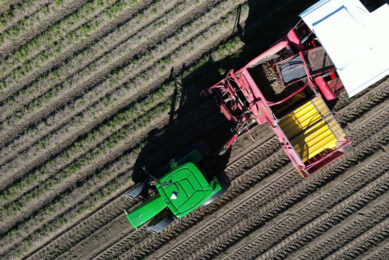How safe are autonomous agricultural machines?

Protecting people plays a crucial role in self-driving machines. With his doctorate at the Osnabrück University of Applied Sciences, Dr. Christian Meltebrink paved the way for their use in the field and on the farm.
What do sensors on a self-propelled agricultural machine have to be able to do in order to detect a person safely and reliably, even in difficult environmental conditions? With this question Dr. Christian Meltebrink is working together with the company B. Strautmann & Söhne GmbH u. Co KG in his cooperative doctorate at the Osnabrück University of Applied Sciences and the Technical University of Berlin.
Protecting people
Automation can be a great relief for farmers. Especially since they are having increasing difficulties finding staff due to the shortage of skilled workers. Together with the company Strautmann & Söhne, he wanted to develop an autonomous feed mixer that independently removes feed from the silo, drives it to the stable and feeds the animals. “It is of course very important that the vehicle is safe and does not hit people, for example. “It also has to function reliably and be usable even in rain, fog, darkness or dust,” says Meltebrink, who has already completed his master’s degree in “Computer Science – Distributed and Mobile Applications” at the university.
Sensor manufacturers are very interested
This is how the idea for his doctoral thesis came about. There are currently sensors on the market that can recognize people. But how can they be proven to work reliably in an agricultural environment? “A farm, where the farmer’s house is often located and where children play, is a completely different environment than a secure industrial hall,” says Meltebrink
That’s why he developed a new method and implemented it using a self-constructed test bench with which a wide variety of sensors can be tested and compared. “We seem to have hit open doors. Originally, five different sensors were to be tested. But the interest of the sensor manufacturers was so great that in the end we had 15 sensors on the test bench instead of five,” says Prof. Dr. Arno Ruckelshausen, who supervised the doctorate at the university. He was supported by Prof. Dr. Cornelia Weltzien from the Technical University of Berlin.
Reflection of human skin
In addition to selecting different sensors, the right test specimen was also crucial. In the experiment, this represents the person that the sensors are supposed to recognize. “We started with a simple mannequin. Its proportions correspond to those of a human, but it cannot, for example, correctly imitate the light reflection of human skin.” Meltebrink therefore had to research for a long time until he found a test specimen that worked for all sensors. He also experimented with different clothing.
The test stand with sensors and test specimens stood in a field in Hagen am Teutoburg Forest for almost two years and was exposed to wind and weather. This meant that a wide variety of environmental conditions could be tested. Based on the data collected, different sensors and in particular different types of sensors can now be compared with one another.
His test stand has now moved from the test facility in Hagen to the Agro-Technicum site on the Westerberg university campus. The results will now be further worked on there: the data will be evaluated and additional sensors will be tested.
Join 17,000+ subscribers
Subscribe to our newsletter to stay updated about all the need-to-know content in the agricultural sector, two times a week.



